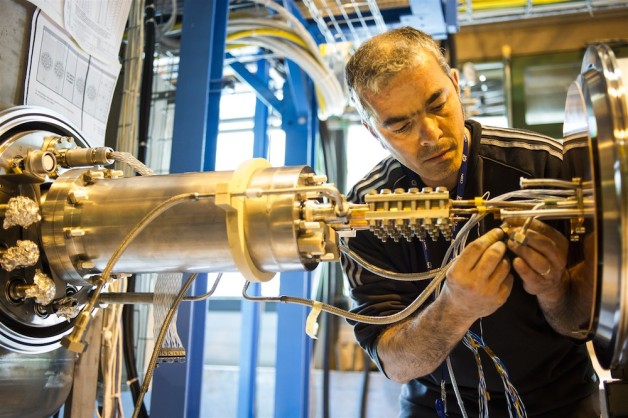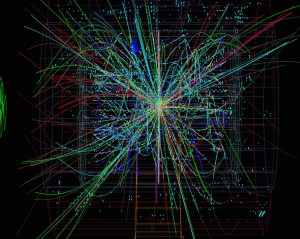
Hydraulic connections of the Fast Cycle Magnet cable to allow the cooling of the magnet’s conductor ( Cable in conduit type) with supercritical helium. Credit: Maximilien Brice
In March, when researchers flip the switch to the world’s largest, most powerful particle accelerator, scientists from all over the world will be watching. Physicists expect the refurbished, higher-energy Large Hadron Collider (LHC) will build on the 2012 discovery of the Higgs particle and crack open even more mysteries of the universe.
Last week, Berkeley Lab researchers, Beate Heinemann and Peter Jacobs were on a panel of scientists that discussed the scientific implications of this new and improved accelerator. At the annual meeting of American Association for the Advancement of Science in San Jose, the researchers summarized their expectations.
Overall, the consensus among the panelists: the LHC’s second run will produce more data to refine the Standard Model—the theory that describes subatomic particles and the forces that dictate their behavior. This refinement is needed, said Heinemann, because there are still fundamental physics questions the Standard Model can’t address.
Questions remain about gravity (Why is it so weak?); antimatter (Why is there so little of it?); and dark matter, the mysterious and invisible substance that makes up nearly a quarter of the universe (What particle might be responsible?).
The LHC first came on line in 2010, costing nearly $12 billion and taking more than a decade to build. Between 2010 and early 2013, it operated nearly continuously at lower energy than it was designed to run at, up to 8 trillion electron volts. By the summer of 2012, news broke that two LHC experiments called ATLAS and CMS had found evidence for the Higgs boson, a particle theorized to give other particles their mass. A year later, theoretical physicists Peter Higgs and Francois Englert, who predicted the particle, won the Nobel Prize in physics.
Since 2013, the LHC has been shut down for maintenance. Engineers and physicists have upgraded detectors and improved accelerators in preparation for a run at 13 trillion electron volts, nearly maximum energy. Protons will be smashed together at unprecedented speeds. In effect, the energy of this proton beam is comparable to that of a freight train; the beam can easily melt through 500 kilograms of copper.
The higher beam energy provides a “huge, new particle-mass range,” said Heinemann, which means scientists will see particles that were previously invisible. “You can think of it like a microscope that’s able to resolve shorter distances,” she said. Some of these particles might give clues to why the universe is made of more matter than antimatter and why gravity is such a weak force compared to the electromagnetic, weak, and strong forces.
Also, at higher energies, there will be more Higgs particles to examine, said Heinemann, who is the deputy spokesperson for the ATLAS experiment. Scientists are keen to take a closer look at the Higgs to see how closely it tracks with theoretical predictions of the Standard Model. If it’s off by too much, it might mean that completely new physics has been discovered. Moreover, said Heinemann, the Higgs could be a portal to finding new particles such has those related to dark matter since, she said, the Higgs might actually decay into dark matter particles.

Event displays from the first proton – lead ion collisions at the LHC, seen by the ALICE experiment. Credit: Thaeder, Jochen; Kolleger, Thorsten; Alt, Torsten
In addition to new particles, the souped-up LHC will also help expand the study of exotic forms of matter that harken back to the early universe. Berkeley Lab’s Peter Jacobs discussed the ALICE experiment, which, in conjunction with experiments at the Relativistic Heavy Ion Collider at Brookhaven National Lab, creates and studies a form of matter called quark-gluon plasma.
This plasma, a roiling, exploding fireball of fundamental particles, “mimics the earliest stages of the big bang,” said Jacobs. The universe was made of mostly quark-gluon plasma in its first microseconds, but then the quarks and gluons collapsed into protons and neutrons as the universe quickly cooled.
The new LHC will give ALICE ten times more data than before so scientists can better probe the unusual properties of the quark-gluon plasma. It’s a type of matter that isn’t entirely understood, full of complex collisions and fluid dynamics, all happening at temperatures 100,000 times hotter than the core of the sun. In a quark-gluon plasma, particles called jets scatter within the fireball, allowing scientists to chart the activity inside the plasma. “Run two gives us the potential to use this process with much more precision and control,” Jacobs said.
LHC scientists expect to have fresh data by the middle of 2015. “We hope it’ll be even more exiting than the first LHC run,” says Heinemann. Jay Hauser, physicist at UCLA and AAAS panel participant noted that the LHC roadmap is long and extends into the 2030s. “We’re just at the beginning of this machine,” Hauser said.